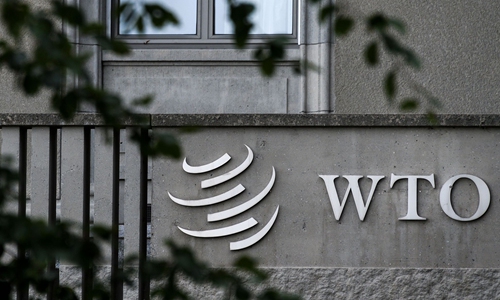HOME >> SOURCE
China’s status as developing country undeniable
Source:Global Times Published: 2019/12/11 22:44:34

A sign of the WTO on its headquarters in Geneva Photo: VCG
China's Ambassador to the WTO Zhang Xiangchen made an excellent point in dismissing the latest US proposal regarding developing-country status at the fifth General Council meeting this year held on Monday and Tuesday.Assuming that there are one or two billionaires in Antigua and Barbuda, which only has a population of 100,000, then the country would be classified as "high-income," but it is by no means a developed country because everyone else is poor, Zhang said.
Whether a country is a developing one is clearly not necessarily measured by the World Bank's "high income" standards, nor is it up to some in Washington.
At the heart of the US demand for an end to the special and differential treatment for countries designating themselves as developing ones is the intention of challenging China's developing-country status and depriving it of its legitimate rights and interests under the WTO rules, regardless of whether China actually meets the standards of a developed country.
It is more crucial than ever for the international community to correctly understand China's status as a developing country amid the long-time debate over how to evaluate a country's development status. There are more than enough facts and theories that could justify why China is still a developing country and deserves special treatment corresponding to its stage of development.
While China's economy has indeed made remarkable achievements, it doesn't necessarily mean that China is already a developed country. Generally speaking, China still lags far behind developed countries in terms of economic and social development levels. In 2018, per capita GDP in China was less than $10,000, below the world average. Meanwhile, China's urbanization rate for its permanent resident population was 59.58 percent in 2018, while the rate in developed countries is usually around 80 percent. Moreover, there is still a large gap between urban and rural areas and among different regions in China, with prominent wealth inequalities.
As of the end of 2018, there were still 16.6 million people living below the national poverty line in China. No developing country has ever had such a large economic scale and influence as China, especially at a time when its per capita economic indicators are still low in all respects. This is mainly because China has a population of nearly 1.4 billion, and this large population makes the Chinese economy appear so big.
Although it is not uncommon to see some observers tout and compare China with some developed powers these days, the country should have a clear picture of itself.
China remains the largest developing country in terms of a wide range of indicators such as per capita levels, industrial structure, employment, innovation ability and balance of development, among others.
In the process of catching up with developed countries, China will not and should not give up its due special treatment, which is the development opportunity granted to developing countries by the multilateral trade rules.
Posted in: GT VOICE